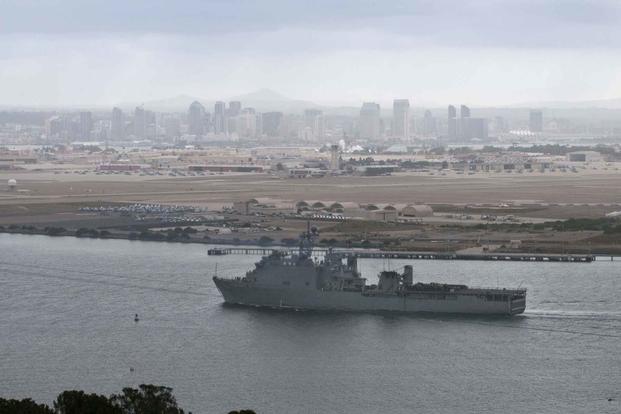A newly released investigation into a near-collision between two Navy warships in San Diego Harbor in November has revealed that some of the credit for avoiding a disaster goes to the quick thinking of two bridge officers.
The officers recognized no effective action was being taken to avoid a collision and made an "incredibly brave" decision to maneuver away, the report found. The Navy findings credited changes to the training of bridge teams put in place after the death of 17 sailors in the at-sea collisions of the USS Fitzgerald and USS John McCain in 2017.
A Navy spokesman emphasized that the sea service would be treating the November incident as a learning experience, and the report noted no punishments would be forthcoming.
On the morning of Nov. 29, the landing dock ship USS Harpers Ferry was leaving San Diego while the destroyer USS Momsen was coming back into port, according to the Navy investigation. The ships met at the narrowest part of the harbor, with the Momsen out of position and the Harpers Ferry officers busy issuing contradicting orders on the bridge.
The officer in charge of navigating the Harpers Ferry, "at the critical moment, recognized that the [ship's commander] was not taking effective action to prevent collision, believed he had the best situational awareness, and took proactive and effective action," the investigation found.
The report went on to say that the officer's subsequent decision to maneuver the Harpers Ferry to port "was an incredibly brave one, the correct one, and was the second critical step that prevented collision that day," the report noted.
Finally, investigators credit the Momsen's commander for turning at the same moment. The report said the decision was the third and final critical step -- "well-timed and executed" -- to avoid the ships colliding in the harbor.
The incident may not have been made public except that a local webcam operator. San Diego Web Cam, a social media account that streams video of the harbor, captured and broadcasted the entire near-collision. Its footage and tweets are cited by investigators.
Over the span of 10 to 15 minutes, the incident played out on the video, shown from the perspective of two web cameras and with some communications between the two ships played in the background.
Although redacted in the report, the web camera operator said that the Navy told him the ships got as close as 35 yards. The video and audio provided Navy experts and observers data to analyze.
"This near-miss collision between warships reminds us of the inherent risk present during operations at sea," Vice Adm. Roy Kitchener, the commander of Naval Surface Forces, wrote in his letter accepting the report.
The two ships ended up in the close call through a series of errors from both crews.
The Momsen had deviated from its planned route and had a tug attached while bringing on a harbor pilot. This meant it started its turn in the harbor later than planned, confusing and boxing in the Harpers Ferry.
As a result, the Harpers Ferry commander, Cmdr. Eric Winn, ordered his ship to slow, then stop, in an attempt to give the Momsen more time. However, these decisions, made in a period of uncertainty, were the wrong call.
The decisions "reduced his maneuverability when he needed it the most," the report noted. "These actions show that [Winn] struggled in that moment to arrive at the right solution to get [his ship] out of danger."
Investigators decided that period lasted "almost 1 minute" -- at the same time the ships closed about 333 yards.
Plus, the pier that Winn thought the Momsen could be going to was occupied by another ship.
Further complicating the situation for the Harpers Ferry was a small electrical fire in the command information center that took out its surface radar. Meanwhile, the ship's executive officer, the second in command, "did not provide adequate forceful backup ... and should have been more engaged," the report found.
However, the Navy report said the backup provided by the Harpers Ferry navigator and officer of the deck was exactly the type of support they should have provided to Winn. It was "an affirmation of the Harpers Ferry bridge team's emphasis on training and the robust changes made in Surface Navy OOD training since the events of Fitzgerald and John S. McCain," according to the report.
The report recommended a raft of changes to how Navy ships conduct close passages and similar port transits in the future, which Kitchener largely accepted. The three-star admiral also ordered the top officers of both ships to report to him with self-assessments of the incident "to improve their respective performances and those of their crews."
In the meantime, the fate of the privately owned San Diego Web Cam that originally captured the entire incident is less certain. The webcam account announced Wednesday that it was being ordered to remove the cameras, which are set up on a national park hillside overlooking the bay.
Military.com reached out to the Naval Criminal Investigative Service which, through a spokesman, confirmed that they "recently expressed force protection concerns to the National Park Service related to the privately owned webcams" but emphasized that "ultimately the decision to remove the webcams was made by the National Park Service."
Military.com reached out to the National Park Service but did not receive a reply.
The account alleged that the move was a direct result of it broadcasting the incident between the Momsen and Harpers Ferry. "This spiteful behavior not only robs Navy families of an important connection to their loved ones, it robs the public of an important public service," the account tweeted Wednesday.
-- Konstantin Toropin can be reached at konstantin.toropin@military.com. Follow him on Twitter @ktoropin.
Related: Navy Overhauls Ship Navigation Training After Deadly Collisions













